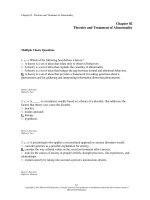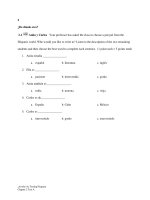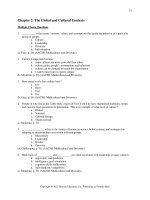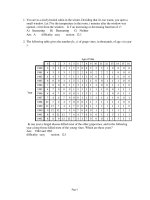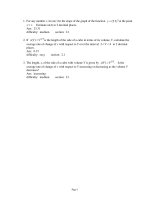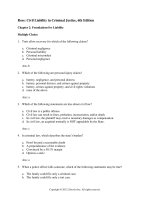Civil liability in criminal justice 6th edition darrell ross test bank
Bạn đang xem bản rút gọn của tài liệu. Xem và tải ngay bản đầy đủ của tài liệu tại đây (263.1 KB, 5 trang )
Ross: Civil Liability in Criminal Justice, 6th Edition
Chapter 2: Foundations for Liability
Multiple Choice
1. Torts allow recovery for which of the following claims?
a.
b.
c.
d.
Criminal negligence
Personal liability
Criminal misconduct
Personal negligence
Ans: b
2. Which of the following are personal injury claims?
a.
b.
c.
d.
battery, negligence, and personal distress
battery, personal distress, and crimes against property
battery, crimes against property, and civil rights violations
none of the above
Ans: a
3. Which of the following statements are true about civil law?
a.
b.
c.
d.
Civil law is a public offense.
Civil law can result in fines, probation, incarceration, and/or death.
In civil law, the plaintiff may receive monetary damages as compensation.
In civil law, an acquittal normally is NOT appealable by the State.
Ans: c
4. In criminal law, which describes the state’s burden?
a.
b.
c.
d.
Proof beyond a reasonable doubt
A preponderance of the evidence
Convinced by a 50.1% margin
Options a and c
Ans: a
5. When a police officer kills someone, which of the following statements may be true?
a. The family could file only a criminal case.
b. The family could file only a tort case.
Copyright © 2013, Elsevier Inc. All rights reserved.
2-2
c. The family could file both a criminal and a tort case.
d. The family could file neither a criminal nor a tort case.
Ans: c
6. Which of the following best describes intentional tort?
a.
b.
c.
d.
Torts can be against people or property
Torts that often arise from failing to perform a particular duty
Torts do not question the officer’s state of mind.
All of the above
Ans: a
7. Which of the following statements is correct about negligent torts?
a. Negligent torts often arise from failing to perform a particular duty, and an officer’s state
of mind is considered.
b. Negligent torts often arise from failing to perform a particular duty, and only occur when
the act leads to an injury.
c. Negligent torts often arise from failing to perform a particular duty, and can be only be
against a person.
d. Negligent torts are more likely to prevail if gross negligence is proven.
Ans: d
8. Which of the following is NOT a typical state tort law category?
a.
b.
c.
d.
Conditions of confinement
Assault
Invasion of property
Wrongful death
Ans: a
9. What are Title 18 U.S. Code §241 and §242?
a. §241 is Criminal Liability for Deprivation of Civil Rights, and §242 is Conspiracy to
Deprive a Person of Rights
b. §241 is Conspiracy to Deprive a Person of Rights, and §242 is Criminal Liability for
Deprivation of Civil Rights
c. §241 is Civil Liability for Deprivation of Civil Rights, and §242 is Criminal Liability for
Deprivation of Civil Rights
d. None of the above
Ans: b
Copyright © 2013, Elsevier Inc. All rights reserved.
2-3
10. DOJ prosecutions of Title 18, U.S. Code §242 cases increased by approximately what
percent between 1998 and 2011?
a.
b.
c.
d.
About 20%
About 40%
About 60%
About 80%
Ans: b
11. Which of the following are some of the top charges in which §242 actions are prosecuted?
a.
b.
c.
d.
sexual assault of an arrestee or prisoner, suicide, and battery
suicide, battery, and excessive force
battery, excessive force, and sexual assault of an arrestee or prisoner
excessive force, sexual assault of an arrestee or prisoner, and robbery/theft
Ans: d
12. Which of the following provides a civil remedy to plaintiffs who can show that two or more
officers conspired to deprive them of their civil rights?
a.
b.
c.
d.
Title 42, U.S. Code §1983
Title 42, U.S. Code §1985
Title 18, U.S. Code §241
Title 18, U.S. Code §242
Ans: b
13. Which of the following is true about §210401 of the Violent Crime Control and Law
Enforcement Act of 1994 (Title 42, U.S. Code §§ 14141 and 14142)?
a. The Act permits the Department of Justice to investigate patterns or practices of
misconduct in local police departments
b. The Act was passed partially in response to the Rodney King incident.
c. The Act requires the collection of statistics on “police abuse”
d. All of the above
Ans: d
14. Which of the following is true of the Americans with Disabilities Act (ADA)?
a. Permits the Department of Justice to investigate a criminal justice agency allegedly in
violation of ADA
b. Gives prisoners access to the courts
Copyright © 2013, Elsevier Inc. All rights reserved.
2-4
c. Permits the Department of Justice to file a lawsuit in federal court against a criminal
justice agency to enforce ADA
d. All of the above
Ans: c
15. Which of the following is true of criminal justice administrative liability?
a. Personnel in both state and federal agencies are bound by and subject to sanctions in their
respective departments.
b. Personnel in both state and federal agencies are bound by administrative rules in their
respective departments.
c. Rules that violate an employee’s rights are not legally binding.
d. All of the above
Ans: d
16. Tort actions are criminal legal actions arising out of situations between private properties.
a. True
b. False
Ans: b
17. The two types of negligent tort cases are simple and complex.
a. True
b. False
Ans: b
18. There were twice as many 18 U.S. Code §242 cases filed in 2011 compared to 1998.
a. True
b. False
Ans: b
19. The Civil Rights of Institutional Persons Act (CRIPA) permits the Attorney General to bring
civil lawsuits against state institutions regarding the civil rights of those housed in the
facility.
a. True
b. False
Ans: a
Copyright © 2013, Elsevier Inc. All rights reserved.
2-5
20. An Americans with Disabilities lawsuit cannot be filed in conjunction with another legal act.
a. True
b. False
Ans: b
Copyright © 2013, Elsevier Inc. All rights reserved.
